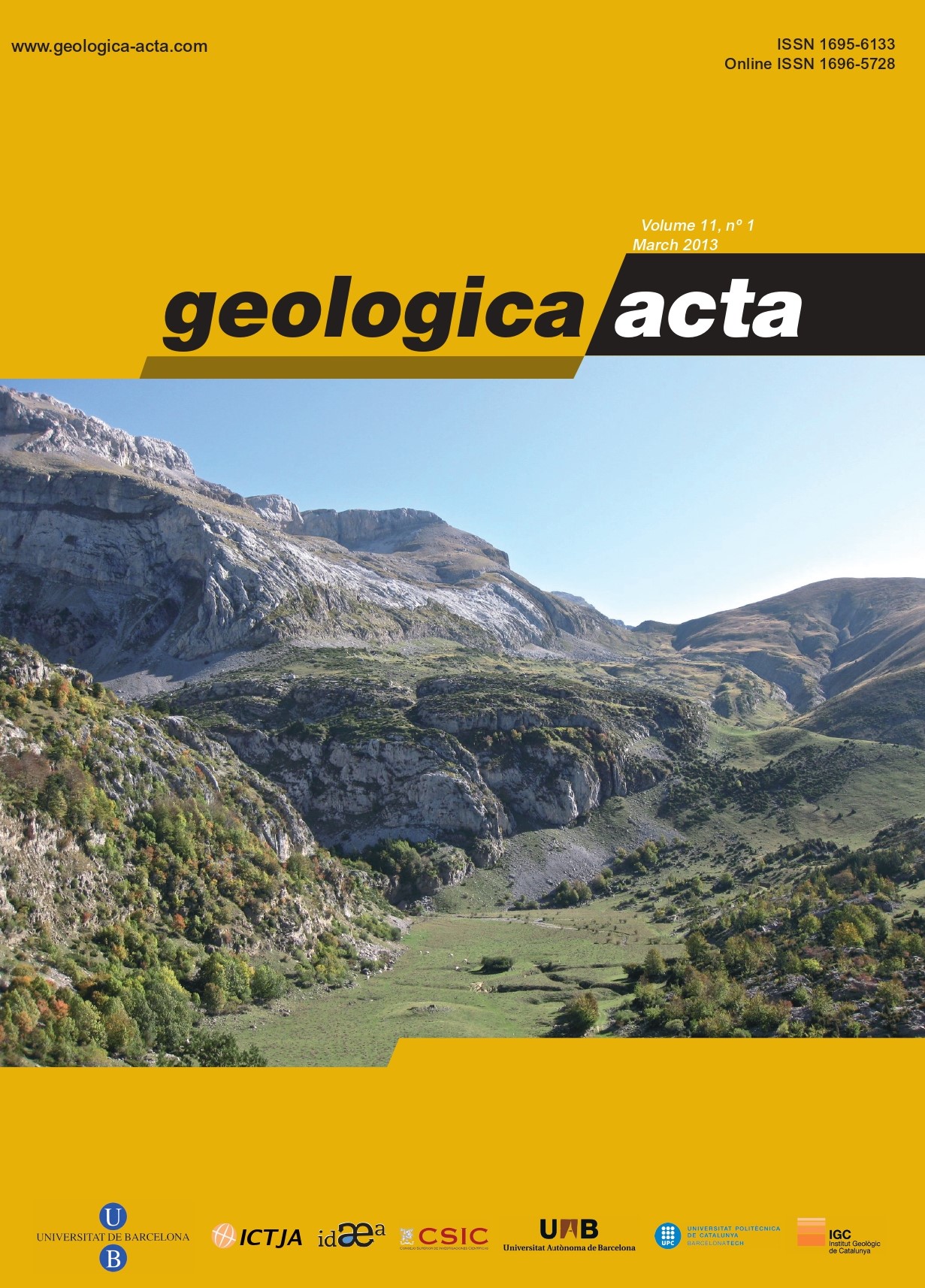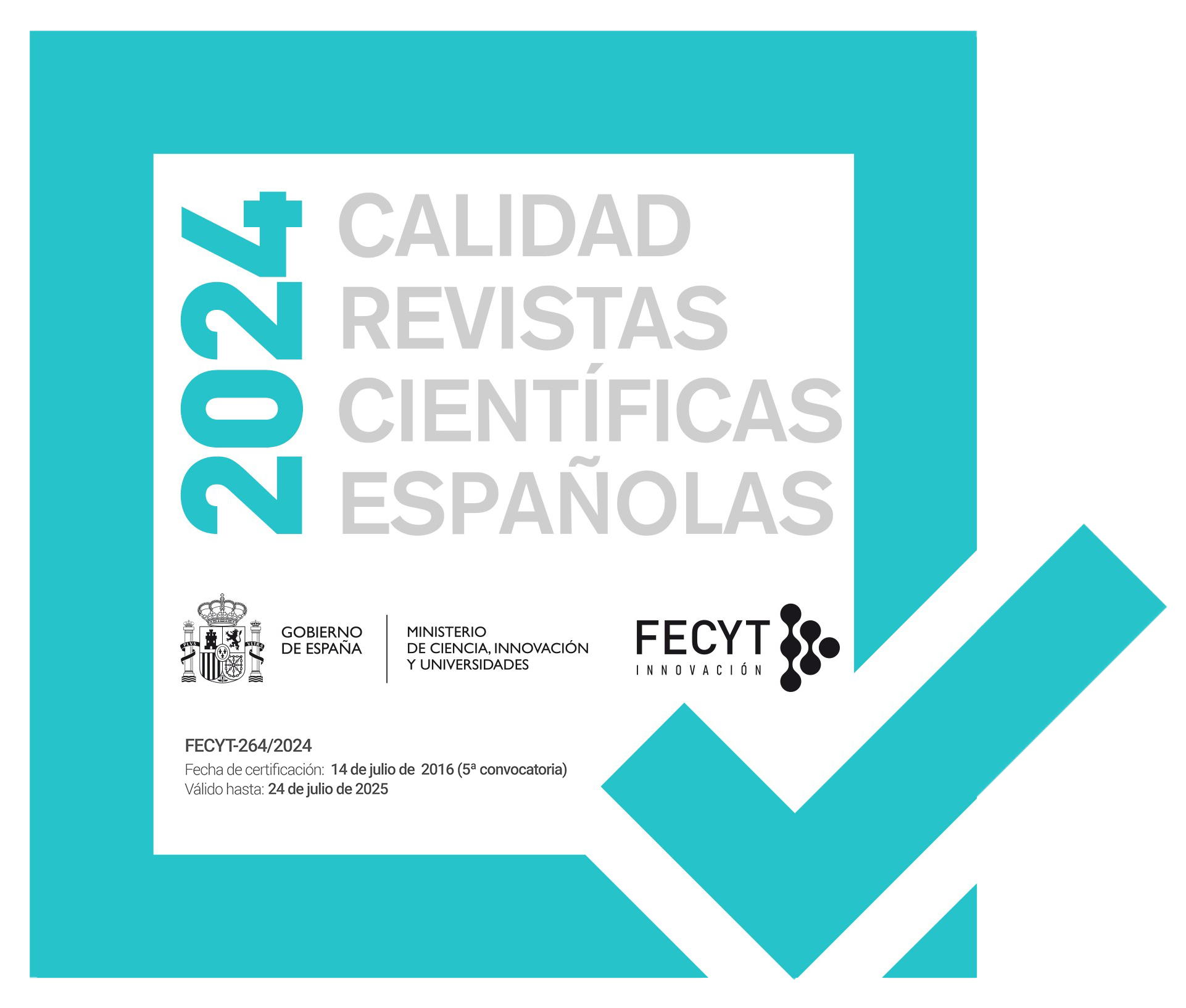Architectural characterization of a delta-front reservoir analogue combining Ground Penetrating Radar and Electrical Resistivity Tomography: Roda Sandstone (Lower Eocene, Graus-Tremp basin, Spain)
DOI:
https://doi.org/10.1344/105.000001778Keywords:
Reservoir analogue, GPR, ERT, Delta sandstones, Eocene, South-pyrenean foreland basinAbstract
Three-dimensional reconstruction of reservoir analogues can be improved combining data from different geophysical methods. Ground Penetrating Radar (GPR) and Electrical Resistivity Tomography (ERT) data are valuable tools, since they provide subsurface information from internal architecture and facies distribution of sedimentary rock bodies, enabling the upgrading of depositional models and heterogeneity reconstruction. The Lower Eocene Roda Sandstone is a well-known deltaic complex widely studied as a reservoir analogue that displays a series of sandstone wedges with a general NE to SW progradational trend. To provide a better understanding of internal heterogeneity of a 10m-thick progradational delta-front sandstone unit, 3D GPR data were acquired. In addition, common midpoints (CMP) to measure the sandstone subsoil velocity, test profiles with different frequency antennas (25, 50 and 100MHz) and topographic data for subsequent correction in the geophysical data were also obtained. Three ERT profiles were also acquired to further constrain GPR analysis. These geophysical results illustrate the geometry of reservoir analogue heterogeneities both depositional and diagenetic in nature, improving and complementing previous outcrop-derived data. GPR interpretation using radar stratigraphy principles and attributes analysis provided: 1) tridimensional geometry of major stratigraphic surfaces that define four units in the GPR Prism, 2) image the internal architecture of the units and their statistical study of azimuth and dips, useful for a quick determination of paleocurrent directions. These results were used to define the depositional architecture of the progradational sandbody that shows an arrangement in very-high-frequency sequences characterized by clockwise paleocurrent variations and decrease of the sedimentary flow, similar to those observed at a greater scale in the same system. This high-frequency sequential arrangement has been attributed to the autocyclic dynamics of a supply-dominated deltafront where fluvial and tidal currents are in competition. The resistivity models enhanced the viewing of reservoir quality associated with cement distribution caused by depositional and early diagenetic processes related to the development of transgressive and regressive systems tracts in high-frequency sequences.
References
Annan, A.P., Cosway, S.W., 1994. GPR frequency selection. Kitchener (Ontario, Canada), June 12-16, Proceeding of the Fifth International Conference on Ground Penetrating Radar, 747-760.
Brown, L.F., Fisher, W.L., 1980. Seismic stratigraphy interpretation and petroleum exploration. Tulsa (Oklahoma), Continuing Education Course Note Series 16. American Association of Petroleum Geologists Tulsa, 56pp.
Corbeanu, R.M., Soegaard, K., Szerbiak, R.B., Thurmond, J.B., McMechan, G.A., Wang, D., Snelgrove, S.H., Forster, C.B., Menitove, A., 2001. Detailed internal architecture of a fluvial channel sandstone determined from outcrop, cores and 3-D ground-penetrating radar: example from the mid-Cretaceous Ferron Sandstone, east-central Utah. American Association of Petroleum Geologists Bulletin, 85, 1583-1608.
Corbeanu, R.M., Wizevich, M.C., Bhattacharya, J.P., Zeng, X., McMechan, G.A., 2004. 3-D architecture of ancient lower delta plain point bars using groundpenetrating radar, Cretaceous Ferron Sandstone, Utah. In: Chidsey, T.C., Adams, R.D., Moris, T.M. (eds.). Regional to wellbore analog for fluvial-deltaic reservoir modeling: The Ferron Sandstone of Utah: American Association of Petroleum Geologists, Studies in Geology, 50, 427-449.
Crumeyrolle, P., Soudet, H., López-Blanco, M., Roda Team, 1991. Partitioning of a deltaic reservoir controlled by base-level changes. A case study: the Roda Deltaic Complex. Notingham (United Kingdom), 13th International Sedimentological Congress, International Association of Sedimentologists (IAS), Abstracts, 114-115.
Davis, J.L., Annan, A.P., 1989. Ground penetrating radar for high resolution mapping of soil and rock stratigraphy. Geophysical Prospecting, 37, 531-551.
Gawthorpe, R.L., Collier, R.E.Ll., Alexander, J., Leeder, M., Bridge, J.S., 1993. Ground penetrating radar: application to sandbody geometry and heterogeneity studies. In: North, C.P., Prosser, D.J. (eds.). Characterisation of Fluvial and Aeolian Reservoirs. Geological Society of London, 73 (Special Publications), 73, 421-432.
Grasmueck, M., Weger, R., Horstmeyer, H., 2005. Full-resolution 3D GPR imaging. Geophysics, 70, K12-K10.
Groenenboom, J., van der Kruk, J., Zeeman, J.H., 2001. 3D GPR data acquisition and the influence of positioning errors on image quality. Amsterdam, 11-15 June 2001, 63rd Conference and Technical Exhibition, 4pp.
Hlal, O., 2008. Diagenesis and Reservoir-Quality Evolution of Paralic, Shallow Marine and Fluvio-lacustrine Deposits. Links to Depositional Facies and Sequence Stratigraphy. Doctoral Thesis. Uppsala Universitet, 66pp.
Jol, H.M., Bristow, C.S., 2003. GPR in sediments: advice on data collection, basic processing and interpretation, a good practice guide. In: Bristow, C.S., Jol, H.M. (eds.). Ground Penetrating Radar in Sediments. Geological Society of London, 211 (Special Publications), 211, 9-27.
Jol, H.M., Bristow, C.S., Smith, D.G., Junck, M.B., Putnam, P., 2003. Stratigraphic imaging of the Navajo Sandstone using ground-penetrating radar. Lead. Edge, 22, 882-887.
Lee, K., Zeng, X.X., McMechan, G.A., Howell, C.D., Bhattacharya, J.P., Marcy, F., Olariu, C., 2005. A ground penetrating radar survey of a delta-front reservoir analog in the Wall Creek Member, Frontier Formation, Wyoming. American Association of Petroleum Geologists Bulletin, 89, 1139-1155.
Lee, K., Gani, M.R., McMechan, G.A., Bhattacharya, J.P., Nyman, S.L., Zeng, X., 2007. Three-dimensional facies architecture and three-dimensional calcite concretion distributions in a tide-influenced delta front, Wall Creek Member, Frontier Formation, Wyoming. American Association of Petroleum Geologists Bulletin, 91, 191-214.
Lee, K., Szerbiak, R., McMechan, G.A., Hwang, N., 2009. A 3-D ground-penetrating radar and wavelet transform analysis of the morphology of shoreface deposits in the Upper Cretaceous Ferron Sandstone Member, Utah. American Association of Petroleum Geologists Bulletin, 93, 181-201.
Lehmann, F., Green, A.G., 2000. Topographic migration: Implications for acquisition and processing. Geophysics, 65, 836-848.
Loke, M.H., Barker, R.D., 1996. Rapid least-squares inversion of apparent resistivity pseudosections by a quasi-Newton method. Geophysical Prospecting, 44, 131-152.
López-Blanco, M., 1996. Estratigrafía secuencial de sistemas deltaicos de cuencas de antepaís: ejemplos de Sant Llorenç del Munt, Montserrat y Roda (Paleógeno, Cuenca de antepaís surpirenaica). Doctoral Thesis. Barcelona (Spain), Universitat de Barcelona, Acta Geologica Hispanica, 31(4, Abridged version), 91-95.
López-Blanco, M., Marzo, M., Muñoz, J.A., 2003. Lowamplitude, synsedimentary folding of a deltaic complex: Roda Sandstone (Lower Eocene), South-Pyrenean Foreland Basin. Basin Research., 15, 73-96.
Marzo, M., Muñoz, J.A., Vergés, J., López Blanco, M., Roca, E., Arbués, P., Barberà, X., Cabrera, L., Colombo, F., SerraKiel, J., 1998. Sedimentation and tectonics: case studies from Paleogene continental to deep water sequences of the South- Pyrenean Foreland Basin (NE Spain). In: MeléndezHevia, A., Soria, A.R. (eds.). Instituto Tecnológico Geominero de España, Madrid. 15th International Association of Sedimentologists Field Trip Guide Book, 199-251.
Martinius, A.W., Molenaar, N., 1991. A coral-mollusc (GoniareaCrassatella) dominated hardground community in a siliciclastic-carbonate sandstone (the Lower Eocene Roda Formation, Southern Pyrenees, Spain). Palaios, 6, 142-155.
Meigs, A.J., 1997. Sequential development of selected Pyrenean thrust faults. Journal of Structural Geology, 19, 481-502.
Mitchum, R.M.Jr., Vail, P.R., Sangree, J.B., 1977a. Seismic stratigraphy and global changes of sea level, Part 6: stratigraphic interpretation of seismic reflection patterns in depositional sequences. In: Payton, C.E. (ed.). Seismic Stratigraphy-applications to hydrocarbon exploration. American Association of Petroleum Geologists Memoir, 117-133.
Mitchum, R.M.Jr, Vail, P.R., Thompson, S.III, 1977b. Seismic stratigraphy and global changes of sea level, Part 2: the depositional sequence as a basic unit for stratigraphic analysis. In: Payton, C.E. (ed.). Seismic Stratigraphy-applications to hydrocarbon exploration, American Association of Petroleum Geologists Memoir, 26, 53-62.
Molenaar, N., Van de Bilt, G.P., Van den Hoeck Ostende, E.R., Nio, S.D., 1988. Early diagenetic alteration of shallow marine mixed sandstones: an example from the Lower Eocene Roda Sandstone Member, Tremp-Graus Basin, Spain. Sedimentary Geology, 55, 295-318.
Muñoz, J.A., 1992. Evolution of a continental collision belt: ECORSPyrenees crustal balanced cross-section. In: McClay, K.R. (eds.). Thrust Tectonics. London, Chapman & Hall, 235-246.
Muñoz, J.A., 2002. Alpine tectonics I: the Alpine system north of the Betic Cordillera: the Pyrenees. In: Gibbons, W., Moreno, T. (eds.). London. The Geology of Spain. Geological Society, 370-385.
Nio, S.D., 1976. Marine transgressions as a factor in the formation of sandwave complexes. Geologie en Mijnbouw, 55, 18-40.
Pringle, J.K., Clark, J.D., Westerman, A.R., Gardiner, A.R., 2003. The use of GPR to image three-dimensional (3D) turbidite channel architecture in the Carboniferous Ross Formation, County Clare, western Ireland. In: Bristow, C.S., Jol, H.M. (eds.). Ground Penetrating Radar in Sediments. Geological Society of London, 211 (Special Publications), 315-326.
Puigdefàbregas, C., Samsó, J.M., Serra-Kiel, J., Tosquella, J., 1985. Facies analysis and faunal assemblages of the Roda sandstone formation, Eocene of the southern Pyrenees. Abstracts 6th Regional Meeting of Sedimentology. Lérida, Spain. International Association of Sedimentologists, 639-642.
Szerbiak, R.B., McMechan, G.A., Corbeanu, R.M., Forster, C., Snalgrove, S.H., 2001. 3-D characterization of a clastic reservoir analog: From3-D GPR to a fluid permability model. Geophysics, 66, 1026-1037.
Tosquella, J., 1988. Estudi Sedimentològic i Biostratigràfic de la Formació Gresos de Roda (Eocè, Conca Tremp-Graus). Msc.
Thesis. Barcelona, Universitat de Barcelona, 540pp.
Tingdahl, K.M., 2003. Improving seismic chimney detection using directional attributes. Developments in Petroleum Science, 51, 157-173.
Tinterri, R., 2007. The Lower eocene Roda sandstone (Southcentral Pyrenees): an example of a flood-dominated riverdelta system in a tectonically controlled basin. Rivista italiana di paleontologia e stratigrafia, 113, 223-256.
Ward, S.H., 1990. Resistivity and Induced Polarization Methods. In: Ward, S.H. (ed.). Geotechnical and environmental geophysics. Tulsa, Society of Exploration Geophysicists, 1, 147-189.
Van Eden, J.G., 1970. A reconnaissance of deltaic environment in the Middle Eocene of the south-central Pyrenees, Spain. Geologie en Mijnbouw, 49(2), 145-157.
Yang, C.S., Nio, S.D., 1989. An Ebb-tide depositional model -a comparision between the modern Eastern Scheldt tidal basin (southwest Netherlands) and the Lower Eocene Roda Sandstone in the southern Pyrenees (Spain). Sedimentary Geology, 64, 175-196.
Downloads
Published
Issue
Section
License

This work is licensed under a Creative Commons Attribution-ShareAlike 4.0 International License.
Copyright
Geologica Acta is the property of the UB, GEO3BCN, IDAEA and UAB. Geologica Acta must be cited for any partial or full reproduction. Papers are distributed under the Attribution-Share Alike Creative Commons License. This license allows anyone to reproduce and disseminate the content of the journal and even make derivative works crediting authorship and provenance and distributing possible derivative works under the same or an equivalent license.
Author Rights
Authors retain the copyright on their papers and are authorized to post them on their own web pages or institutional repositories. The copyright was retained by the journal from the year 2003 until 2009. In all cases, the complete citation and a link to the Digital Object Identifier (DOI) of the article must be included.
The authors can use excerpts or reproduce illustrations of their papers in other works without prior permission from Geologica Acta provided the source of the paper including the complete citation is fully acknowledged.




